מערת סדום
Sdom cave - Sedom Cave - Sodom’s Cave
Useful Information
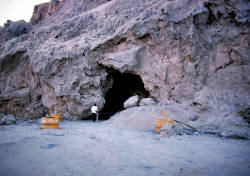
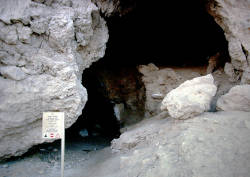
| Location: |
Mount Sedom, Dead Sea.
At the road 90 from Jericho to Eilat, at the southern end of the Dead Sea, 3 km South of Newe Zohar. (31.0867465, 35.3949774) |
| Open: | no access due to possible collapse |
| Fee: | n/a |
| Classification: |
 Salt Cave Salt Cave
|
| Light: | bring torch |
| Dimension: | L=1.799 m. |
| Guided tours: | self guided |
| Photography: | allowed |
| Accessibility: | no |
| Bibliography: |
Amos Frumkin (2009):
Formation and dating of a salt pillar in Mount Sedom diapir, Israel,
Geological Society of America Bulletin 2009;121 (1-2);286-293,
DOI
Amos Frumkin, Derek C. Ford (1995): Rapid entrenchment of stream profiles in the salt caves of Mount Sedom, Israel Earth Surface Processes and Landforms 20(2):139 - 152 · March 1995, : DOI pdf |
| Address: | - |
| As far as we know this information was accurate when it was published (see years in brackets), but may have changed since then. Please check rates and details directly with the companies in question if you need more recent info. |
|
History
| 1937 | potash works in Sedom established |
| 1952 | road to Sedom built. |
| 1987 | cave survey by Amos Frumkin et al resulted in 6 km total length. |
| MAR-2019 | resurvey of old part and new discoveries results in a new length of 10,200 m. |
Description
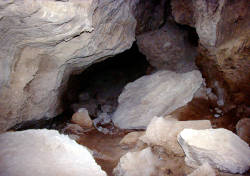

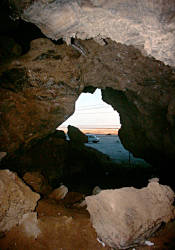
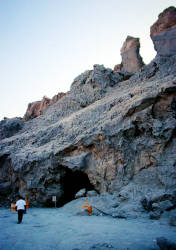
Sedom or Sodom is a famous name from the Old Testament. The two cities of Sodom and Gomorrah were bad to the bones and God decided to destroy them. Only Lot with his family was allowed to leave the city, but with the advice not to look back. However, Lot’s wife was curious, so she looked back and was transformed into a pillar of salt. (Genesis 19:26)
Although many of the biblical stories have showed a historic core, this story has still no archaeological proof. There are theories that the two cities were located in the plains south of the Dead Sea. But until today, no archaeological evidence proofs this. So it is only a theory that the cities may have been destroyed by a seismic event in this tectonic active Dead Sea graben.
The place today called Sedom, is a rough car park beneath the road. But it has two sights, making it a stop on sightseeing tours. Above the car park, on top of the hill is a pillar formed of salt and called Lot’s Wife.
But not only this pillar, the whole ridge where this hill belongs to is formed of a mixture of salt and silt. The ridge called Sedom Mountain is 11 km long by 3 km wide and consists of 98% salt. These are sediments of the Dead Sea, which flooded this rather flat area numerous times during thousands of years. The salts were dated to be around 50,000 years old, so these are actually deposits of Lake Lisan, the cold age version of the Dead Sea. From about 70,000 to 10,000 ago the climate was much colder, and the higher amounts of rain produced a much bigger lake than today, which is called Lake Lisan by geologists. It was up to 17 km wide and 200 km long, and its surface was only 200 m below sea level. The salt deposits from this time were later covered by other sediments like marls and limestones, and finally started to move along cracks, a process called halokinetics. The salt formed a diapir and was lifted where it is now, up to 250 m higher than the Dead Sea. At the first glimpse, the rocks look like silt, but a closer look reveals the high content of different salts.
Fortunately, this area is arid, a desert climate, as any rain would immediately wash away the salt. But sometimes it may rain even in the desert, currently about once a year. The run-off water that collects on the surface cuts through the salt to form a unique series of daylight shafts that drain into a maze of caves.
So the salt cave called מערת סדום (Sdom Cave, Sodom’s Cave), guess why, is the second sight at this place. It is not really impressing for the regular tourist, especially as it may not be entered due to a possible collapse. But if you would enter carefully, which you would never do because there are signs that it is forbidden, you could see a brownish passage which looks quite similar to a passage in gypsum or limestone. It was formed by solution by flowing water. Because of the small amount of marl in the salt the walls are covered by clay, and it’s not easy to spot the salt. The passage winds horizontally into the mountain and is easy to explore, as it is high enough to walk upright and quite level. At the end, you reach a vertical shaft. Karren at the walls show that it was formed by water entering into the cave from the surface above.
Salt caves are probably the rarest caves on earth, as they require a special geographic and climatic situation. And even then, they have a very short lifespan, when you return a year later, it may already be gone. For a long time this was actually the only salt cave listed on showcaves.com, as it was the only one, which is possible to reach by a tourist. The Dead Sea area was well-developed for tourism with numerous hotels for people bathing in the salt water for health reasons. There are the hotels of En Bokek and the kibbuz En Gedi nearby, also the fortress of Masada. The cave is located only 20 m from the road, unfortunately it is forbidden to enter.
There are operators who organize cave trekking trips into the salt caves of Mt Sedom, mostly centered on the abseil down one of the sinkholes. After the abseil, the tour follows the mostly horizontal passage to the resurgence. We read a description about an 80 m abseil, which is quite impressive. The participant was especially impressed as she booked the tour without being informed about this abseil. So be careful to ask about the details of your adventure. Probably it was written prominently in Hebrew, and it was just a problem of translation.
- See also
 Search DuckDuckGo for "Sedom cave"
Search DuckDuckGo for "Sedom cave" Google Earth Placemark
Google Earth Placemark OpenStreetMap
OpenStreetMap Mount Sodom (visited: 16-APR-2019)
Mount Sodom (visited: 16-APR-2019) Sodom and Gomorrah (visited: 16-APR-2019)
Sodom and Gomorrah (visited: 16-APR-2019) Sodom Caves (visited: 16-APR-2019)
Sodom Caves (visited: 16-APR-2019) How to hike the magnificent Mount Sodom in Israel! (visited: 16-APR-2019)
How to hike the magnificent Mount Sodom in Israel! (visited: 16-APR-2019) Sodom Salt Cave Israel; How Is This A Secret? (visited: 16-APR-2019)
Sodom Salt Cave Israel; How Is This A Secret? (visited: 16-APR-2019) Rappelling Cave of salt (visited: 16-APR-2019)
Rappelling Cave of salt (visited: 16-APR-2019)
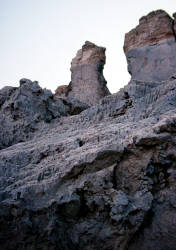

 Index
Index Topics
Topics Hierarchical
Hierarchical Countries
Countries Maps
Maps